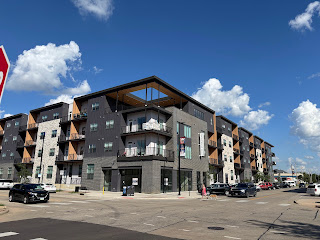 |
| The six lanes of 1st Avenue (Iowa Rte. 922) by Coe College |
My home state's Department of Transportation, on the other hand, has for some time been suggesting to towns that they could put their state routes on "road diets" (see Strong Towns 2019). Typically this involves taking a four-lane road and converting it to three--one lane for through traffic in each direction, and a central turn lane. This leaves room to create bike lanes, on-street parking, bulbouts at crosswalks, room for street trees, or other treatments that enhance the safety and convenience of pedestrians and cyclists. Not only does this accommodate more modes of transportation than the current number of one, but it reduces crashes and traffic speeds without impacting overall traffic flow (Schmitt 2014; Speck 2012: 163-167, both cited below). All this serves to support the local business climate as well.
The Iowa Department of Transportation Design Manual lists four reasons for towns to consider road diets:
- high accident rates involving left turning movements, sideswipes, rear-ends, or crossing traffic
- the need for traffic calming
- pedestrian and bicyclist safety issues
- “defacto” left turn lanes: areas where a four-lane facility is operating like a three-lane facility, with the inside lanes operating as left turn lanes.
IDOT considers cutting to three lanes appropriate up to an average daily traffic count of 15,000-17,000. What probably matters more is the highest volume of traffic on a typical day: the Federal Highway Association Road Diet Informational Guide recommends 750 vehicles per hour per direction (vphbd) as the top for a road diet, but suggests towns "consider cautiously" peak volumes as high as 875. Both manuals contain a number of reasons not to do it as well: roads that serve to move traffic rather than to access property, that have vehicles with frequent stops or slow starts, near railroad crossings, or where there is on-street parking (IDOT). This seems overly cautious to me, though I can certainly see concerns about backups at at-grade crossings--many trains move slowly through downtown Cedar Rapids, and there's only one bridge over the tracks--or waiting for someone to parallel park.
The central Iowa town of Indianola is considering a second round of road diet on State Rte. 92 (Albertson). 2016 ADTC for 2nd Av is 10000-12000 west of the intersection with US65/69, where it's been converted to three lanes, lower east of the intersection where four lanes remain. IDOT data show the four-lane portion has three times as many crashes as the four-lane portion, despite the lower traffic count.
 |
| Downtown Grundy Center (Google Maps screenshot) |
Perhaps not surprisingly, there has been some pushback. The IDOT manual warns, Typically, initial community reaction to the conversion will be negative since it seems logical to assume that eliminating a lane will reduce capacity and increase delays. These gains in safety, commercial viability, and overall pleasantness seem to come at the expense of auto drivers. A lot of these drivers have children who walk to school, or enjoy a good walk or bike ride themselves, but others are not willing to yield the policy privileges they've enjoyed for decades. A Los Angeles group called Fix the City, complains of those who "want to make driving our cars unbearable by stealing traffic lanes from us on major streets and giving those stolen lanes to bike riders and buses" (Linton 2019).
In Iowa, Rep. Sandy Salmon (R-Janesville) wants to ban IDOT from promoting/recommending road diets in towns (Albertson 2019). Her bill, House File 41 would prevent IDOT from doing anything other than providing statistical data to the towns through which its highways run. As it works in Iowa, the final decisions rest with the affected towns, as it should be--right, conservatives?--but there are always those who see any step away from auto-centrism as a threat to western civilization that must be opposed at any cost.
Other towns where IDOT recommendations have met with local pushback:
- Knoxville: ADTC 2014 on Iowa Rte. 14 peaks at 10700 south of the intersection with Madison St. At intersection with Pleasant St it's 7900 s and 9200 n
- Grundy Center: ADTC 2017 on Iowa Rt 14 is 6200 on G Av where Rtes 14 & 175 run together. When they split it's 3590 on 4th St (Rte. 14) and 4590 on G Av (Rte. 175)
As I've noted in earlier posts, the future of Iowa's small towns continues to be very much in doubt. Traditional small towns retain the grid patterns and older commercial buildings that inspire urbanists everywhere. Maybe those downtowns can't all be brought back to life, but how running a four-lane highway through them helps town life is beyond me.
MAIN SOURCES:
Jeff, "Grundy Center Fights Back Against Three-Laning," Iowa Highway Ends (Etc.), 13 February 2019
Joe Linton, "L.A. Anti-Road Diet Conspiracy Trolls Trying to Go National," Streetsblog LA, 4 February 2019
Angie Schmitt, "The Airtight Case for Road Diets," Streetsblog USA, 29 October 2014
Jeff Speck, Walkable City: How Downtown Can Save America, One Step at a Time (Farrar Straus and Giroux, 2012)













